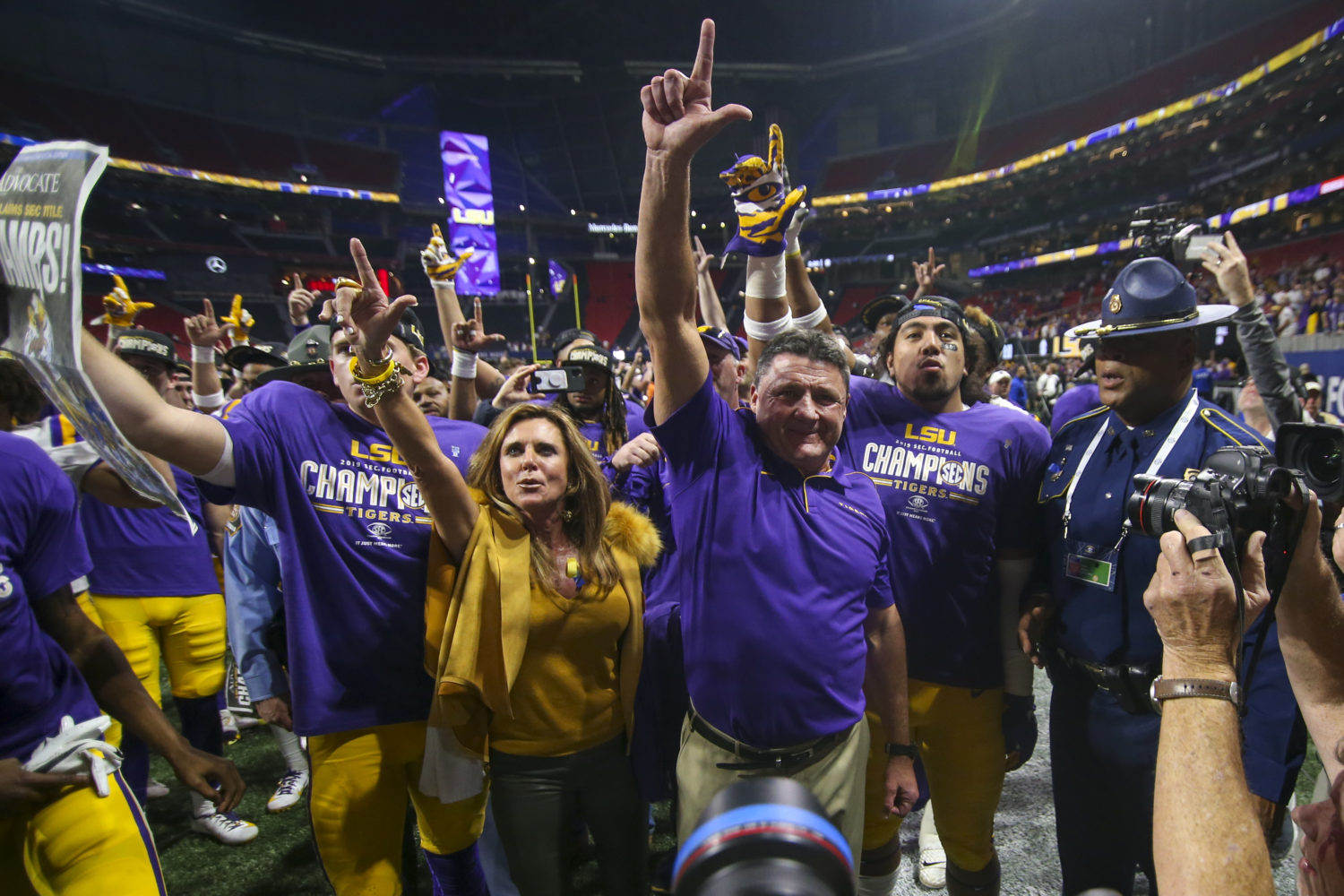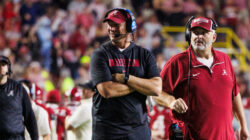
SEC 360: Not-so-good to Great: The Evolution of Ed Orgeron
By Al Blanton
Published:
“I really am impressed. I’ve been for him all the way…You struggle for your coaching career trying to find a notch. Where do I belong? Where do I fit in the best? Where can I give the maximum effort of what I’ve got? And I think he found it as the head football coach at LSU. And he had to kind of struggle, here to here to here, before he got that notch. I really admire him.”
– Bobby Bowden on Ed Orgeron
* * * * *
Two years ago, I was standing with Ed Orgeron at Jack Daniel’s Bar & Grill inside of L’Auberge Casino in Lake Charles, Louisiana. That week, I’d been assigned to interview Coach O while he was the main attraction at a series of stops on the “Tiger Tour” — essentially a bonanza of LSU alumni and boosters — and because this was my second 5-minute interview with the newly-named LSU head coach in as many days, we were pals.
A cub reporter to this type of high-energy setting, I nervously fired several questions to him, my knees rattling beneath me as I asked him about the 3 F’s in life: faith, family and football. But then something remarkable happened. As we were separating to our respective arenas — him into the fray of actual SEC football and me into the fringe world of journalism about SEC football — he looked back at me, slapped me in the stomach with the back of his hand, and said, “You do a good job … keep it up.”
I couldn’t help but smile. I’d just gotten a pep talk from Ed Orgeron. No charge, mind you. Shoot, I might have well been one of the LSU players, for Pete’s sake!
As I pulled back from those two short interviews and began patching together my piece, I had this feeling down deep in my gut that Orgeron was going to do a good job at LSU. The person I talked to was not the meathead the media portrayed but a guy who had fire in his eyes and seemed to be consumed with one singular thought: turning an already-good football program into an outstanding one.
Not to mention, he was a guy who could absolutely work a room. I watched him as he circulated the banquet hall at the Tiger Tour. I noted his charisma, how he could ingratiate himself to varying groups, how he moved throughout the masses with ease and charm. I could tell that this was the job he’d been waiting for his whole life, and he wasn’t going to screw it up. I got this feeling that sooner or later, he was going to beat Alabama. I felt like an 11-2 season wasn’t too far-fetched.
What I didn’t anticipate was that within 2 short seasons, his team would be 13-0, he would renovate the LSU offense to the extent that a Tigers quarterback would win the Heisman Trophy, and LSU would be on the doorstep of a national championship.
Absolutely surreal.
How did this all happen?
Good (or not-so-good) to Great
In his book “Good to Great,” author Jim Collins wrote, “Few people attain great lives, in large part because it is just so easy to settle for a good life.”
Such is the case in any profession, including coaching. If you’ll notice, many 6-6 or 8-4 coaches continue to be 6-6 or 8-4 coaches throughout the balance of their careers. Have they simply settled for the good life? Assuredly, some are simply content on remaining average, on doing things the way they’ve always done them. Others lack the intestinal fortitude, perseverance, or confidence to move to another level. Some die on the hill of stubbornness.
Those that excel, conversely, are willing to do what it takes to find success. They employ, as Collins suggests, a “ferocious resolve” to become great.
Ed Orgeron has demonstrated that ferocious resolve.
Outside of his small circle, however, few thought he could do it. I wrote in my piece that Orgeron was viewed by many as a “caricature.” What I meant to say was that to many observers, he was viewed as a joke. Someone not to be taken seriously. An energy-drink-sodden former jock who was just going hit the repeat button at LSU.
Now the joke’s on those who doubted him.
The most compelling aspect of Coach O’s evolution from not-so-good to great has been his ability to self-evaluate and change from the hard, malevolent tyrant-like figure in Oxford to the teddy-bear-like players’ coach in Baton Rouge. The same coach who once skinned off in the middle of practice and acted like he was Jack Dempsey walking into a Manassas bar, challenging anyone and everyone to a knock-down brawl, sat mahogany-faced and fighting back tears as Joe Burrow slathered him with praise as he accepted the Heisman, the pseudo father-son vibes passing back and forth between them as if the two souls were connected by a wire.
Remember back in high school when we learned about heliocentric (sun-centered universe) versus geocentric (earth-centered universe)? Similarly, it seems that Orgeron has made a colossal shift from a coach-centric mentality to a player-centric mentality. “Treat ’em like they are your sons!” Orgeron hailed back in 2017. And who doesn’t believe him now? Who doesn’t buy that there’s been a genuine heart-level change inside?
Again, how does this happen?
Perhaps the brilliant minds adjudicating Orgeron’s fate at LSU discounted the profound effect Ole Miss had on him. Perhaps Oxford was the lesson in humility Orgeron needed, the impetus for the change within. Perhaps the gruff brute was more malleable than we originally thought.
Another lesson Orgeron learned at Ole Miss was that he couldn’t do everything, that there’s great benefit in delegating. LSU didn’t need him to be the coaching octopus, tentacles reaching into every facet of the program. In direct contrast to Ole Miss, LSU’s Orgeron has demonstrated the ability to hire and promote good people and let them do their jobs. Last year he elevated Steve Ensminger from tight ends coach to OC and this year tabbed Joe Brady as the man who would revolutionize his offense by going to the spread. It’s all seemed to work rather efficiently and without a major hiccup. In the meantime, he sought out and landed the quarterback he wanted — a frustrated Ohio State backup who had been riding the pine for 2 seasons under head coach Urban Meyer. Retrospectively, it’s safe to say that those brilliant moves have panned out. Record-smashing performances by Burrow and the LSU offense, an undefeated regular season, an SEC championship and a Heisman have been the result of Orgeron’s adaptability and ingenuity.
But Orgeron isn’t the first to go from good to great. For a moment, let’s pan the careers of two other coaches and see if we can find a bit more gold.
Saban and Bowden
To discover the greatest about-face from averageness in college football history, one only has to look across the aisle from Orgeron at another head coach in the SEC West. Yes, I’m talking about Nick Saban.
A long, long time ago, Saban was a young head coach struggling to win in the Big Ten. In his first 3-and-a-half years as head coach at Michigan State, Saban posted a modest 24-20-1 record. Then in late 1998, he Sabaned out and became the coach — well, he became Nick Saban.
It was a change akin to Dr. David Banner transforming into the Incredible Hulk. Which begs the question: To what — or whom — could we attribute this change?
The answer, at least partly, is Saban himself — a man who had the wherewithal and the flat out guts to look introspectively. The second catalyst was a man named Lionel Rosen, professor at Michigan State University, who helped Saban synthesize his coaching and teaching philosophy into an execution-focused mentality that would later be introduced to the world as “The Process.” Rosen encouraged Saban to teach his kids not to look at the scoreboard, but focus on excellence in each play. A micro versus macro approach, if you will.
The results followed. Saban’s crucible — his Ole Miss — arrived on Nov. 7, 1998 in Columbus, Ohio. His Michigan State team, 4-4 at the time, arrived as a heavy underdog — 28 points to be exact — to No. 1 Ohio State. But something clicked for the Spartans that day, and Saban pulled off a monumental upset. “We came in here with the attitude we were the squirts in the neighborhood who had to pick a fight with the bully,” Saban told the postgame press.
As much as the game was a total embarrassment for OSU, it was a harbinger for things to come for any future team coached by Nick Saban. Before that game, Saban was 32-22-1 (.581) as a head coach. After it, he’s 210-43 (.830). This level of success has been possible because Saban was willing to self-evaluate and change his philosophy midstream.
Bobby Bowden had a similar experience in Tallahassee. One would think that Florida State was always the Florida State that blew the top off of the world in the late ’80s and early ’90s. Not so. A quick review of history will reveal that the Seminoles were 6-5, 9-3, 8-4, 7-3-2, 9-3 and 7-4-1 from 1981 to 1986. Then, mysteriously, the floodgates opened in ’87, and FSU began a 14-year run of finishing in the top 5. Greatness, for Florida State or anyone else for that matter, could not have occurred by osmosis, so how did Bobby Bowden elevate the Florida State program from a perpetual Gator Bowl team to the top program in the country by 1993?
The answer, at least in part, was Bowden’s ability to recruit outstanding players. “I think around ’85 is when we really broke through,” Bowden told me in a recent phone interview. “That recruiting class must have had 3 or 4 1st-round draft choices, eventually. Deion Sanders, Sammie Smith, Odell Haggins … we had quite a few boys that played pro football that came out of that class, and I think that broke the ice.”
The second thing was that Bowden needed — and got — a little bit of luck. In the ’80s, the state of Florida was a recruiting battleground, as Miami, Florida State and Florida closed in on elite high school talent like a school of piranhas. But in 1984, the NCAA put a serious dent in Florida’s recruiting ability by placing the Gators on 3 years’ probation. Sure, Florida ended up getting players like Pensacola’s Emmitt Smith, but probation was enough of a sty for Miami and Florida State to take the lead on the recruiting trail. “I think that was what opened the door for us,” Bowden said of Florida’s travails.
Throughout the years, though, Bowden demonstrated an ability to make moves to his program’s benefit. The arrival of a new defensive coordinator, Mickey Andrews, in 1984 helped to solidify his defense and the louder and more stylish arrival of Prime Time in 1985 provided a new edge. But it was Bowden’s ability to identify the type of player he wanted that was perhaps the most important factor in the Seminoles’ comeuppance.
Bowden had always been cognizant of the tectonic shifts in college football and how he needed to adjust with the times, and after losing to Oklahoma for two seasons in a row in 1979 and ’80, he knew his team was deficient in one area in particular. “In the early ’80s — around ’83, ’84, ’85 — we really started recruiting speed,” Bowden said. “We wanted speed to be one of the big factors we were after.”
And just as Orgeron fitted his offense to suit Joe Burrow, Bowden, never rigid, was always adaptable to his players’ strengths. The true brilliance in Bowden was that even when he made a change, he fine-tuned that change to get the best possible outcome. An example would be in the early 1990s, when Bowden installed the option to suit dual-threat quarterback Charlie Ward. Later, after implementing the scheme, Bowden realized that Ward was better suited to scramble on a busted play after he’d dropped back to pass than he was to roll out and make the pitch. And because Bowden gave Ward the freedom to improvise, because he did not encumber Ward with pesky parameters that might have stifled his talent, he was able to claim the national title that had long eluded him.
So what would Bobby Bowden tell the 6-6 coach who wanted to get better?
“You better go get the best players. My philosophy on football coaching was very simple. It’s whoever gets the best players is going to win. And that’s usually the case. If I’ve got better players than you, I’m going to beat you. And if you’ve got better players than me, you can beat me. So if I was talking to a 6-6 coach and trying to tell him how to get better, I’d say, ‘Son, go get better players,’” Bowden said.
A final thought
This past weekend, as I watched Joe Burrow accept the Heisman Trophy and the camera panned to Coach O, I thought about those two short moments I spent with him at L’Auberge casino the spring of 2017. I couldn’t help but wonder what the doubters thought of him now, the people who laughed when LSU removed the “interim” tag in late November of 2016 and made Edward James Orgeron Jr. the 32nd head coach in school history.
And I thought, “How great a moment is this for college football, and for coaches in general?” Regardless of whether or not you like LSU, you have to respect what Orgeron and fellow ragamuffin, Joe Burrow, have done. You have to respect the love between these two men, men who have captivated the world with a season and a storyline for the ages.
There’s something to be said for a guy who just lowers his head and goes to work every day. Eventually, he’ll figure things out. That’s Joe Burrow. That’s Ed Orgeron.
In the end, what Orgeron means is that often, the road less traveled — the road from good to great — is feared, not because of the undergrowth, but because it is marked by the footprints of failure.
Al Blanton is the owner of Blanton Media Group, publishers of 78 Magazine and Hall & Arena.







